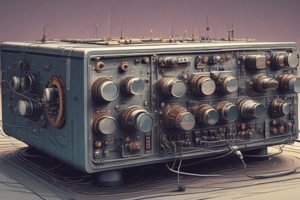Podcast
Questions and Answers
What type of I/O would you use to detect a range of values in a system?
What type of I/O would you use to detect a range of values in a system?
- Binary I/O
- Digital I/O
- Analog I/O (correct)
- Mixed I/O
Which of the following devices is considered an analog input device?
Which of the following devices is considered an analog input device?
- Force sensor (correct)
- Lamp brightness controller
- Push button
- Limit switch
Which of the following is a function of digital output devices?
Which of the following is a function of digital output devices?
- Controlling fluid release
- Operating high-power circuits (correct)
- Measuring distance to objects
- Adjusting motor speed
What is an example of an analog output device?
What is an example of an analog output device?
Which device detects when a laser beam is broken as a safety measure?
Which device detects when a laser beam is broken as a safety measure?
What kind of events do digital input devices typically detect?
What kind of events do digital input devices typically detect?
Which device is not classified as an analog input device?
Which device is not classified as an analog input device?
What is the primary purpose of analog control valves?
What is the primary purpose of analog control valves?
Flashcards are hidden until you start studying
Study Notes
Difference Between Analog and Digital I/O
- Analog I/O detects or controls events with a range of values.
- Digital I/O operates in binary, managing yes/no or on/off scenarios.
Analog Input Devices
- Force Sensors: Measure applied forces, can be fixed or attached to robots.
- Potentiometers: Used in various applications such as control knobs or motor position detection.
- Light Sensors: Detect the intensity of light; used in photoelectric sensors for object distance measurement.
- Vision Sensors: Measure light levels, functioning similarly to light sensors.
Analog Output Devices
- Conveyor Belt Motor Speed: Allows integration of belt speed control into robot systems for advanced applications.
- Analog Control Valves: Precision devices for managing fluid release in hydraulic systems.
- Lamp Brightness: Brightness levels of LEDs or lamps can be finely adjusted.
Digital Input Devices
- Limit Switches: Systems that detect conditions, such as safety doors opening or robots reaching predefined limits.
- Basic Part Detection Sensors: Identify the presence of objects to facilitate part tracking.
- Single-Beam Laser Safety Sensors: Utilize a laser beam interruption to signal entry into unsafe areas.
- Push Buttons: Simple yet crucial devices for initiating or halting pre-programmed sequences.
Digital Output Devices
- Relays: Switches that enable low-power electronics to control high-power circuits.
- Warning Lights: Illuminate to indicate robot operation, serving as a safety alert for workers in the vicinity.
Studying That Suits You
Use AI to generate personalized quizzes and flashcards to suit your learning preferences.




